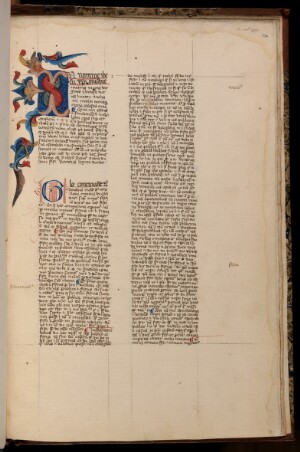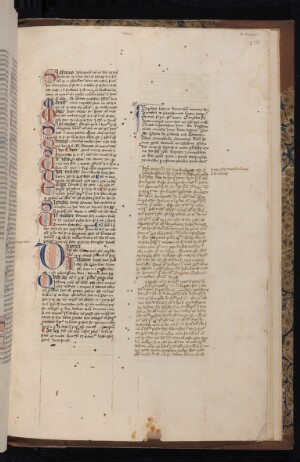Neuton's Italian Books
Michele Campopiano (University of York)
Among the books possessed by John Neuton there are a significant number of manuscripts copied in Italy. Three of them, York Minster, MSS XVI. P. 5, XVI. P. 6 and XVI. P. 7, transmit works of an important Italian jurist and political thinker: Bartolus de Saxoferrato (1313/1314-1357). Bartolus taught law in Pisa and Perugia and was a prolific author. Among his many works we can mention political treatises like the Tractatus de Guelphis et Gebellinis, De regimine civitatis or the De Tyranno. He also commented on the Roman laws and juridical thought known in the Middle Ages as the Corpus iuris civilis (Corpus of civil law) which constituted the foundation of the medieval study of law. MS XVI. P. 5 contains Bartolus's Lectura super codice, a study of the Roman imperial constitutions assembled under Emperor Justinian (the so-called Codex; Justinian reigned 527-565), while MSS XVI. P. 6 and XVI. P. 7 contain his study of two parts of the Digest or Pandects (the so-called Digestum vetus and Digestum novum), a compilation of works of Roman jurists. Together, the three manuscripts constituted an important asset for the study of law.
The manuscripts are large paper codices (MS XVI. P. 5, for example, measures 440 x 295 mm). They are not fancy display manuscripts but above all tools for study: floriate initials, for example on fol. 320r of MS XVI. P. 5 (Fig. 1), pen-flourished and plain initials, together with paraphs, help the consultation of the texts by marking the beginnings of chapters and other subdivisions. The manuscripts also include indication of the divisions of the work into books by adding the corresponding Roman numeral in the top margin. Indications of the content have been added in the top corner of the recto of each folio, usually copying rubrics present in the text. The manuscripts are all written in a readable but quickly executed cursive script which makes use of a large number of abbreviations, particularly for technical terms. The similarities in script and decoration point to a common workshop or at least area of production. This is demonstrated by the fact that the paper of these three manuscripts shares some of the same watermarks - distinctive images or patterns that point to the manufacturer of paper. MS XVI. P. 7 gives us some important information to identify this area and the date of production — the colophon on fol. 278r reads: complete sub incarnacionis anno domini nostri Ihesu Christi millesimo quadrigentesimo primo, die vigesimo quinto mensis iunii hora vesperorum, per me Petrum de Colonia nunc habitatorem terre Montisbellii comitatus Bon[oniensis] ('completed in the year of the incarnation of our lord Jesus Christ 1401, the 25th of June at the hour of Vespers, by me, Peter of Colonia, now living in Montebello in the county of Bologna') (Fig. 2).
Bologna was at the time the centre of a very important university, probably the most important one for the study of law in Europe. It is possible that the manuscripts were produced there through a system, commonly adopted in European universities in the late Middle Ages, known as pecia: the different quires — or booklets — of the exemplar from which the text was copied were distributed to several scribes at the same time, in order to speed up the production process. MS XVI. P. 7 shows some signs that could be pecia marks, partially eliminated in the process of cutting of edges when the manuscript was rebound.
The manuscripts were studied carefully in Northern England, or in any case by Englishmen connected to the Northern province, as several annotations by English hands show. Some of them are very revealing for their content, for example, on fols 10r and 20r of MS XVI. P. 7 we read: nota pro quadam constitutione provincie Ebor[acensis] que incipit Sciendum etc. ('note for some constitution of the province of York that begins Sciendum etc.') or videte filii regi Anglie Henrici quarti ('see the sons of the king of England Henry IV' — although this last reading is dubious given the ambiguous abbreviations used). Another interesting case of cross Anglo-Italian learning is a fourth law manuscript listed in Neuton's will: York Minster, MS XVI. P. 8. It contains a commentary on the Codex, the Roman imperial constitutions assembled under Emperor Justinian, written by Cinus de Pistoia (1270-1336/1337), another famous Italian jurist (and poet). This manuscript is, however, written by English scribes. The manuscript is on parchment, with six foliate initials on fols 1r, 102r, 152v, 234r, 257r and 288r. It displays other initials which clearly try to imitate the ones found in Italian manuscripts, resulting in an interesting example of the fusion of different cultural traditions.
In addition, three of Neuton's Italian manuscripts are now at Peterhouse in Cambridge. The first of these, Peterhouse, MS 36, is a copy of Bartolus's commentary on the Digestum infortiatum, the third part of the Digest, which, together with the two volumes in York, constitute a complete edition of Bartolus's important study of the Digest. This is also likely a pecia copy, although this time on parchment, not on paper, and written in a more elaborate script, also connected to the University of Bologna. The manuscript includes the annotation on fol. 269v: 'Bartholus super Digestum Inforciatum ex dono magistri Iohannis Newton thesaurarii ecclesie Cathedralis Ebor[acensis]' ('Bartolus on the Digestum Inforciatum as the gift of Master John Neuton treasurer of the cathedral church of York'). Another manuscript, Peterhouse, MS 233, further attests the depth of John Neuton's political and juridical interests: it is a copy of the De regimine principum (On the Government of Princes). This work was written by the Augustinian Italian friar Giles of Rome (c. 1243-1316) and was very influential in the history of medieval political thought in general and in England in particular, being translated by John Trevisa into English at the turn of the fifteenth century. The third manuscript, Peterhouse, MS 173, is a more unusual case: it is a composite volume, that is to say a manuscript created by putting together independent quires which did not originally belong to the same production unit. The first part was written in Italy in the second half of the fourteenth century: it contains the Historia destructionis Troiae (The History of the Destruction of Troy) written by the Sicilian Guido delle Colonne in 1287. This Latin work, based on the French Troy romance by Benoit de Sainte-Maure, tells the story of the Trojan War from a different perspective to that of Vergil's Aeneid. Its influence on English literature was great: Lydgate's Troy Book is based on it and Chaucer honours the Sicilian writer by mentioning him in the House of Fame and the Legend of Good Women.
How to cite
Michele Campopiano, 'Neuton's Italian Books', in Hanna Vorholt and Peter Young (eds), 1414: John Neuton and the Re-Foundation of York Minster Library, June 2014, https://yml1414.york.ac.uk/

